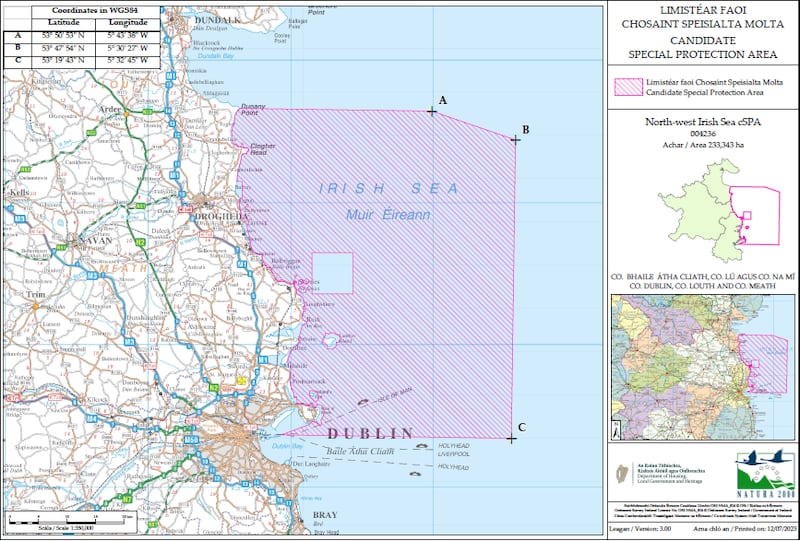A 30km exclusion zone around Rockabill island in the Irish Sea, which supports Europe’s large breeding bird colony for endangered roseate terns, must be imposed if a large wind farm is allowed proceed off north Dublin, it has been claimed.
It is the main demand of the Sustainable Wind-farm Environmental Group (SWEG) in a 70-page document, which includes the views of specialists in ornithology, sea mammals and marine biodiversity, submitted to An Bord Pleanála objecting to the North Irish Sea Array (NISA) offshore wind energy project. It is supported by Balbriggan Community Council and Skerries Tourism. Their campaign was initiated by a group of kayakers familiar with the coastline.
NISA is a joint venture between Norwegian company Statkraft and Danish renewable energy investment company Copenhagen Infrastructure Partners proposing to build 35-49 turbines up to 316m tall off Skerries with the nearest turbine 12.3km from the coastline.
“To fully protect the species, an exclusion zone mirroring the roseate terns’ foraging area of 30km should be put in place around the ecologically sensitive Rockabill Special Protection Area [SPA],” said SWEG spokesman Shane Holland.
READ MORE
This would protect and conserve the roseate tern population and other protected species such as the purple sandpiper, artic tern and common tern, he added.
If allowed proceed, the development will be sited within the new northwest Irish Sea candidate special protection area, which when fully enacted in Irish law will have the same level of protection as other European sites within the Natura 2000 network.

It is a vast expanse of 230,000 hectares of marine waters set to become Ireland’s largest protected area for bird species and adjoins 12 existing Special Protection Areas already designated for protection of birds along the coast.
“Statkraft’s willingness to site a wind farm array 200m from Rockabill SPA shows a complete disregard for one of the rarest seabirds in Europe,” Mr Holland said.
He criticised its methods of determining collision and other risks to roseate terns in environmental assessments “as utterly inadequate”.
“Their claim that birds will fly below the 40m clearance of rotor blades does not stand up to scrutiny,” he said. They were particularly concerned about interference in the flight paths of migrant birds including Brent geese moving north to south to Bull island and Lambay island.
SWEG was a lone voice raising concerns, Mr Holland said, claiming community and sporting organisations were reluctant to comment because of a €4 million a year community fund promised by the developer.
SWEG’s other main objection is to the size and positioning of turbines in both options of Statkraft’s proposal, “which we believe will have a detrimental effect to the seascape, landscape and visual amenity of the sensitive Fingal coastline and the European sites which form part of the Natura 2000 network”.
The group was pro-wind power “but concerned by the way both the size and number of turbines have increased since Statkraft first consulted our community”, Dermot Higgins of SWEG said. “Our worry is these large turbines are too close to Ireland’s shore. An alternative is to move the turbines further out in line with EU norms but Statkraft are unwilling do this.”
The turbines were “three times the size of Dublin Spire, when most offshore wind farms across Europe are smaller and a minimum of 22km from shore ... we believe a very significant number of people living in the Skerries/Balbriggan area are unaware of the potential detrimental damage which will be caused by the proposed development,” Mr Higgins added.
In response to SWEG’s concerns, Tina Raleigh, head of offshore for Statkraft Ireland and NISA project development director, said their aim “has always been to deliver the right project and in the right way based on collaboration and engagement with local communities”.
“Sustainable development is also paramount and we have undertaken detailed ornithological surveys and assessments over several years, as reflected in the planning application, so the project progresses in a way that will minimise negative impact on the local environment and biodiversity – both onshore and offshore,” she added.
All relevant species of the northwest Irish Sea candidate special protection area, including the roseate tern, were considered in three years of meticulous survey works, she said. Consultation with various stakeholders, including the National Parks & Wildlife Service, had highlighted “they do not consider SPAs and offshore wind as incompatible”.
“Other factors – such as the seabed depth – have also influenced the project design and location. As you move away from the shore, Ireland’s seabed depth increases very quickly. NISA will use the proven technology of fixed-bottom wind turbines that can be deployed only in water depths of 50-60m or less.
“NISA is a project of huge strategic importance and will be capable of delivering clean energy to over half a million homes and businesses, illustrating a clear commitment to Ireland’s decarbonisation journey. If planning permission is granted next year, construction could commence in 2026 with the project going into operation by 2029,” Ms Raleigh added.
“We will be reviewing and respectfully considering all the points raised in the submissions, which we expect to receive in the coming days.”
- Sign up for push alerts and have the best news, analysis and comment delivered directly to your phone
- Join The Irish Times on WhatsApp and stay up to date
- Listen to our Inside Politics podcast for the best political chat and analysis












